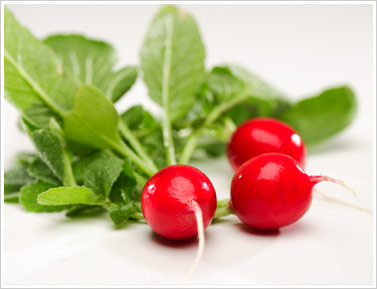
The radish (Raphanus sativus) is an edible root vegetable of the Brassicaceae family that was domesticated in Europe in pre-Roman times. They are grown and consumed throughout the world. Radishes have numerous varieties, varying in size, color and duration of required cultivation time. There are some radishes that are grown for their seeds; oilseed radishes are grown, as the name implies, for oil production. Nutritional value Radish, raw, root only Nutritional value per 100 g (3.5 oz) Energy 66 kJ (16 kcal) Carbohydrates 3.40 g Sugars 1.86 g Dietary fiber 1.6 g Fat 0.10 g Protein 0.68 g Thiamine (Vit. B1) 0.012 mg (1%) Riboflavin (Vit. B2) 0.039 mg (3%) Niacin (Vit. B3) 0.254 mg (2%) Pantothenic acid (B5) 0.165 mg (3%) Vitamin B6 0.071 mg (5%) Folate (Vit. B9) 25 μg (6%) Vitamin C 14.8 mg (25%) Calcium 25 mg (3%) Iron 0.34 mg (3%) Magnesium 10 mg (3%) Phosphorus 20 mg (3%) Potassium 233 mg (5%) Zinc 0.28 mg (3%) Percentages are relative to US recommendations for adults. Source: USDA Nutrient database
Radishes are rich in ascorbic acid, folic acid, and potassium. They are a good source of vitamin B6, riboflavin, magnesium, copper, and calcium. One cup of sliced red radish bulbs provides approximately 20 calories, largely from carbohydrates.